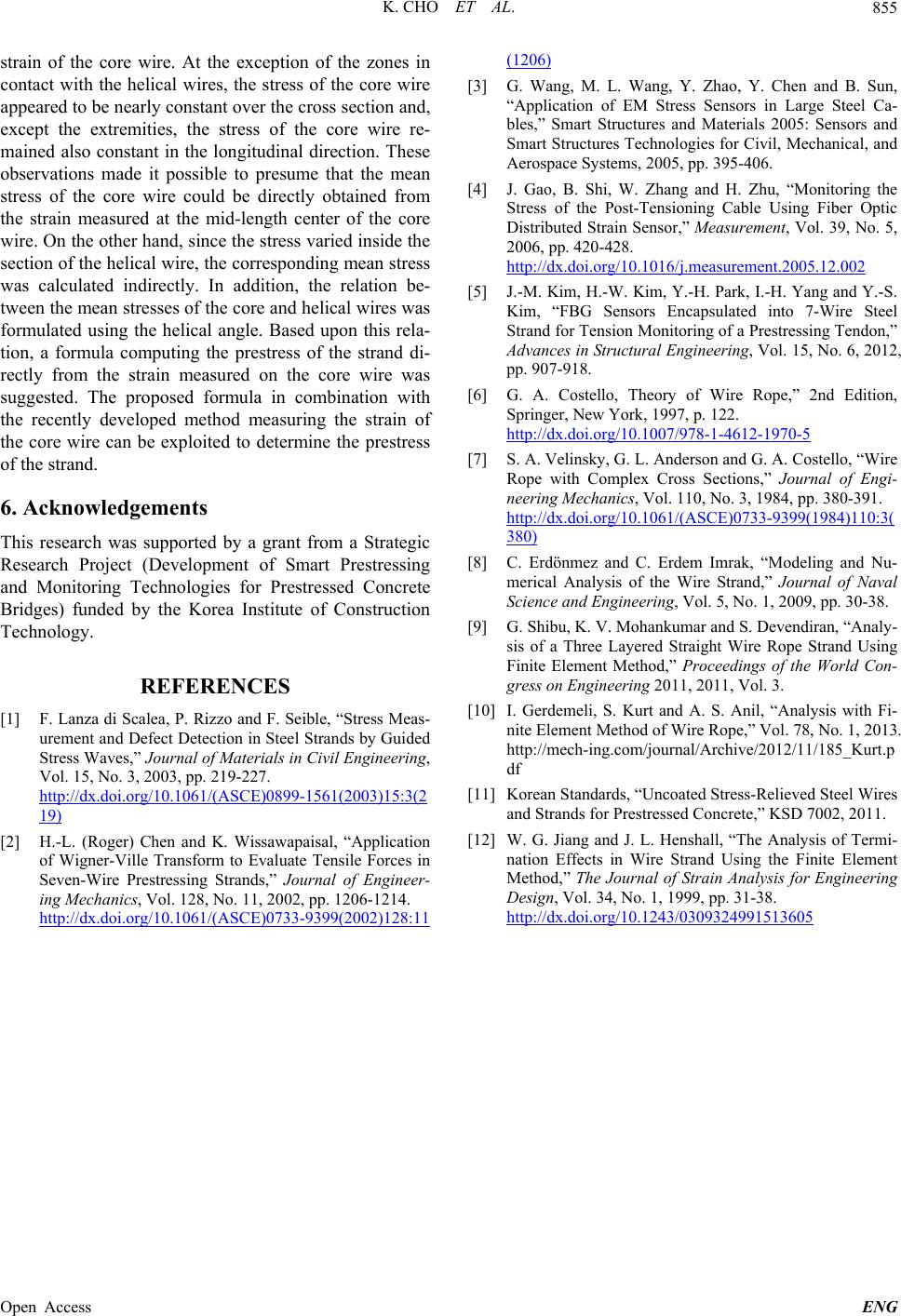
K. CHO ET AL. 855
strain of the core wire. At the exception of the zones in
contact with the helical wires, the stress of the core wire
appeared to be nearly constant over the cross section and,
except the extremities, the stress of the core wire re-
mained also constant in the longitudinal direction. These
observations made it possible to presume that the mean
stress of the core wire could be directly obtained from
the strain measured at the mid-length center of the core
wire. On the other hand, since the stress varied inside the
section of the helical wire, the corresponding mean stress
was calculated indirectly. In addition, the relation be-
tween the mean stresses of the core and helical wires was
formulated using the helical angle. Based upon this rela-
tion, a formula computing the prestress of the strand di-
rectly from the strain measured on the core wire was
suggested. The proposed formula in combination with
the recently developed method measuring the strain of
the core wire can be exploited to determine the prestress
of the strand.
6. Acknowledgements
This research was supported by a grant from a Strategic
Research Project (Development of Smart Prestressing
and Monitoring Technologies for Prestressed Concrete
Bridges) funded by the Korea Institute of Construction
Technology.
REFERENCES
[1] F. Lanza di Scalea, P. Rizzo and F. Seible, “Stress Meas-
urement and Defect Detection in Steel Strands by Guided
Stress Waves,” Journal of Materials in Civil Engineering,
Vol. 15, No. 3, 2003, pp. 219-227.
http://dx.doi.org/10.1061/(ASCE)0899-1561(2003)15:3(2
19)
[2] H.-L. (Roger) Chen and K. Wissawapaisal, “Application
of Wigner-Ville Transform to Evaluate Tensile Forces in
Seven-Wire Prestressing Strands,” Journal of Engineer-
ing Mechanics, Vol. 128, No. 11, 2002, pp. 1206-1214.
http://dx.doi.org/10.1061/(ASCE)0733-9399(2002)128:11
(1206)
[3] G. Wang, M. L. Wang, Y. Zhao, Y. Chen and B. Sun,
“Application of EM Stress Sensors in Large Steel Ca-
bles,” Smart Structures and Materials 2005: Sensors and
Smart Structures Technologies for Civil, Mechanical, and
Aerospace Systems, 2005, pp. 395-406.
[4] J. Gao, B. Shi, W. Zhang and H. Zhu, “Monitoring the
Stress of the Post-Tensioning Cable Using Fiber Optic
Distributed Strain Sensor,” Measurement, Vol. 39, No. 5,
2006, pp. 420-428.
http://dx.doi.org/10.1016/j.measurement.2005.12.002
[5] J.-M. Kim, H.-W. Kim, Y.-H. Park, I.-H. Yang and Y.-S.
Kim, “FBG Sensors Encapsulated into 7-Wire Steel
Strand for Tension Monitoring of a Prestressing Tendon,”
Advances in Structural Engineering, Vol. 15, No. 6, 2012,
pp. 907-918.
[6] G. A. Costello, Theory of Wire Rope,” 2nd Edition,
Springer, New York, 1997, p. 122.
http://dx.doi.org/10.1007/978-1-4612-1970-5
[7] S. A. Velinsky, G. L. Anderson and G. A. Costello, “Wire
Rope with Complex Cross Sections,” Journal of Engi-
neering Mechanics, Vol. 110, No. 3, 1984, pp. 380-391.
http://dx.doi.org/10.1061/(ASCE)0733-9399(1984)110:3(
380)
[8] C. Erdönmez and C. Erdem Imrak, “Modeling and Nu-
merical Analysis of the Wire Strand,” Journal of Naval
Science and Engineering, Vol. 5, No. 1, 2009, pp. 30-38.
[9] G. Shibu, K. V. Mohankumar and S. Devendiran, “Analy-
sis of a Three Layered Straight Wire Rope Strand Using
Finite Element Method,” Proceedings of the World Con-
gress on Engineering 2011, 2011, Vol. 3.
[10] I. Gerdemeli, S. Kurt and A. S. Anil, “Analysis with Fi-
nite Element Method of Wire Rope,” Vol. 78, No. 1, 2013.
http://mech-ing.com/journal/Archive/2012/11/185_Kurt.p
df
[11] Korean Standards, “Uncoated Stress-Relieved Steel Wires
and Strands for Prestressed Concrete,” KSD 7002, 2011.
[12] W. G. Jiang and J. L. Henshall, “The Analysis of Termi-
nation Effects in Wire Strand Using the Finite Element
Method,” The Journal of Strain Analysis for Engineering
Design, Vol. 34, No. 1, 1999, pp. 31-38.
http://dx.doi.org/10.1243/0309324991513605
Open Access ENG